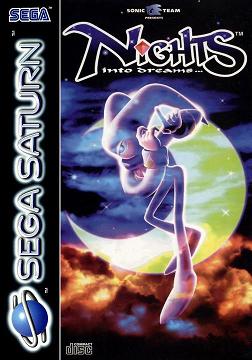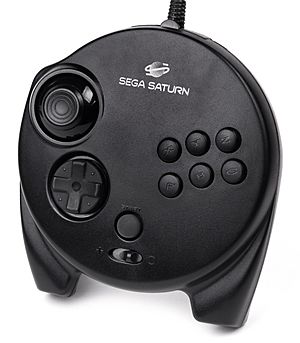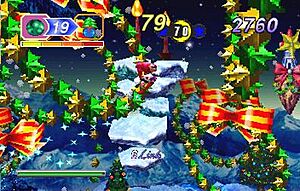Nights into Dreams facts for kids
Quick facts for kids Nights into Dreams |
|
|---|---|

European cover art
|
|
| Developer(s) | Sonic Team |
| Publisher(s) | Sega |
| Director(s) | Naoto Ohshima |
| Producer(s) | Yuji Naka |
| Designer(s) | Takashi Iizuka |
| Programmer(s) | Yuji Naka |
| Artist(s) |
|
| Composer(s) |
|
| Platform(s) | |
| Release date(s) |
5 July 1996
Sega Saturn
|
| Genre(s) | Action |
| Mode(s) | Single-player, multiplayer |
Nights into Dreams is an exciting action game released in 1996. It was made by Sonic Team and published by Sega for the Sega Saturn console.
The game's story follows two teenagers, Elliot Edwards and Claris Sinclair. They enter a special place called Nightopia, which is a dream world where all dreams happen. In Nightopia, they meet Nights, a magical being who has been exiled. Together, they must stop the evil ruler Wizeman. Wizeman wants to destroy Nightopia and then take over the real world.
Players control Nights, flying through Elliot and Claris's dreams. Your goal is to collect enough energy to defeat Wizeman and save Nightopia. The game uses cool 3D visuals. Each level has a time limit, and you need to earn points to move forward.
The idea for Nights into Dreams started in 1992, during the creation of Sonic the Hedgehog 2. Development began in 1994, after Sonic & Knuckles was released. The game's creators, Yuji Naka, Naoto Ohshima, and Takashi Iizuka, led the project. Yuji Naka wanted to create a game about flying. Naoto Ohshima designed Nights as a character that looks like an angel and can fly like a bird.
Nights into Dreams was praised for its amazing graphics, fun gameplay, great music, and unique atmosphere. Many people consider it one of the greatest games of all time. A shorter, Christmas-themed version called Christmas Nights came out in December 1996. The game was later released on PlayStation 2 in 2008. A high-definition (HD) version came out for PlayStation 3, Xbox 360, and Windows in 2012. A sequel, Nights: Journey of Dreams, was released for the Wii in 2007.
Contents
How to Play Nights into Dreams
Nights into Dreams has seven main levels, which are called "Dreams." Three levels are for Claris, three are for Elliot, and they both play the same final level, "Twin Seeds." At first, you can only play Claris's "Spring Valley" and Elliot's "Splash Garden." Finishing one of these unlocks the next level for that character.
You can replay levels to get higher high scores. You get a grade from A to F when you finish a level. To unlock the "Twin Seeds" stage, you need a "C" grade or better in all of your chosen character's levels. You earn points by finishing levels quickly and by flying through rings.
Exploring Dreams and Fighting Bosses
Each level has four "Mares" set in Nightopia and a boss fight in Nightmare. When you start a level, you control Claris or Elliot. Their Ideyas (special spheres that hold emotions like hope and wisdom) are stolen by Wizeman's helpers. Only their Ideya of courage remains.
Your goal in each Mare is to get back one of the stolen Ideyas. You do this by collecting 20 blue chips and taking them to a cage holding the Ideyas. This releases the orb. If you walk around for too long as Claris or Elliot, a giant alarm clock will chase you. If it touches you, the level ends.
Most of the game involves flying. You start flying by walking into the Ideya Palace, where your character merges with the imprisoned Nights. Once you start flying, a time limit begins.
Flying with Nights
When flying, you control Nights along a set path, like in a 2D platformer. You have a limited time before Nights falls and turns back into Claris or Elliot. Hitting an enemy takes away five seconds from your time. You get more time each time you return an Ideya to the Ideya Palace.
Nights can use a "Drill Dash" to fly faster and defeat enemies. If you grab certain enemies, Nights will spin around and launch forward. You can also do cool moves like the "Paraloop." This is when you fly in a full circle, and any items inside the loop are pulled towards Nights.
The game has a combo system called "Linking." You get more points for collecting items and flying through rings quickly, one after another. You can also get Power-ups like speed boosts or point multipliers by flying through special rings.
Scoring and Multiplayer Fun
You get a grade for your score at the end of each Mare. After clearing all four Mares, you get an overall grade for the level. Then, Nights goes to Nightmare for a boss fight against one of Wizeman's powerful Nightmarens. Each boss fight has a time limit. If you run out of time, the game ends. If you win, you get a score bonus based on how fast you defeated the boss. This bonus is added to your Nightopia score to get your final score for that Dream.
The game also has a multiplayer mode. Two players can battle each other using a splitscreen. One player controls Nights, and the other controls Reala. The first player to hit or "paraloop" the other player three times wins.
A-Life System
Nights into Dreams has a unique system called "A-Life." It involves little creatures called Nightopians. Their moods change, and they can even mate to create "Superpians." The more you play, the more Nightopians appear, and the environment of the levels can change.
The A-Life system also affects the music. The tempo, pitch, and melody of the music can change depending on what the Nightopians are doing. This feature uses the Sega Saturn's internal clock, so things can change based on the time of day.
The Story of Nights into Dreams
Every night, human dreams happen in Nightopia and Nightmare, which are parts of the dream world. In Nightopia, different parts of a person's personality are shown as bright, colored spheres called "Ideya."
The evil ruler of Nightmare, Wizeman the Wicked, is stealing this dream energy from sleeping people. He wants to gain power and take control of Nightopia, and eventually the real world. To do this, he creates five beings called "Nightmaren." These are jester-like creatures that can fly, including Jackle, Clawz, Gulpo, Gillwing, and Puffy. He also creates two more powerful Nightmaren: Nights and Reala.
However, Nights refuses to follow Wizeman's evil plans. As punishment, Nights is trapped inside an Ideya palace, which is a container for dreamers' Ideya.
One day, Elliot Edwards and Claris Sinclair, two teenagers from the city of Twin Seeds, have bad experiences. Elliot, a basketball player, loses badly to older students. Claris, a singer, gets stage fright during an audition and loses hope. When they go to sleep, they both have nightmares about these events.
They escape into Nightopia and discover they both have the rare Red Ideya of Courage. This is the only type of Ideya Wizeman cannot steal. Elliot and Claris free Nights, who tells them about dreams and Wizeman's plans. The three of them start a journey to stop Wizeman and bring peace back to Nightopia. After they defeat Wizeman and Reala, Nightopia becomes peaceful again, and the world of Nightmare is controlled.
The next day, in Twin Seeds, a special ceremony is happening. Elliot walks through the parade and sees a vision of Nights looking at him from a billboard. He realizes Claris is performing and rushes to see her. He finds Claris singing well on stage in front of a big audience. They look at each other, and the scene changes to Nightopia, showing their connection to the dream world.
Making the Game: Development
Nights was created by Sonic Team, the same group at Sega that made the Sonic the Hedgehog games. The idea for Nights came up in 1992, but work on the game didn't start until late 1994. Programming began in April 1995, and the whole game took about six months to make.
Yuji Naka was the main programmer and producer. Naoto Ohshima was the director, and Takashi Iizuka was the lead designer. Naka and Ohshima wanted to work on new ideas after spending a lot of time on the Sonic series. The first team had seven people, and it grew to 20 as more programmers joined.
Naoto Ohshima, who created Sonic, designed the character of Nights. He got his ideas from traveling in Europe and western Asia. He decided that Nights should look like an angel and fly like a bird. Yuji Naka first planned for Nights into Dreams to be a slow game. But as they worked on it, the game became faster, similar to Sonic games.
The team was unsure about switching from 2D to 3D graphics. Naka worried that characters made with polygons wouldn't look as good as traditional pixel art. According to Iizuka, it took two years to finish the design and story. They wanted the game to be easy enough for new players to finish, but also challenging for experienced players to replay and get high scores.
Challenges in Making the Game
The team used special Silicon Graphics computers for the graphics and Sega Saturn emulators for programming. They faced challenges because there weren't many other 3D games to learn from. They had to redesign the "Spring Valley" level many times and build everything from scratch.
The development took longer than expected because the team was new to the Saturn hardware. They also weren't sure how to use all the space on the CD-ROM. Iizuka said the hardest part was making 2D-style controls work in a fully 3D game. Naka decided to limit Nights' flying to "invisible 2D tracks." This was because early tests showed that playing in full 3D was too difficult.
The standard Saturn controller wasn't good enough for controlling Nights' flight. So, the team created a new controller, the Saturn analog controller. It took about six months to develop, and they tried many different ideas for it.
Iizuka said Nights was inspired by anime and the Mystère show by Cirque du Soleil. The team also researched dreams and REM sleep, including the ideas of famous thinkers like Carl Jung and Sigmund Freud. Naka said Nights reflected Jung's "shadow" theory, while Claris and Elliot were inspired by Jung's animus and anima ideas.
Game Release
Nights into Dreams was released with an optional gamepad, the Saturn 3D controller. This controller had an analogue stick and analog triggers, designed to make movement easier in Nights. Sonic Team noticed how well the Nintendo 64 controller worked with Super Mario 64 (1996). They realized the regular Saturn controller was better for arcade games than for Nights into Dreams.
During development, the famous director Steven Spielberg visited Sonic Team's studio. He was the first person outside the team to play the game. Naka asked him to use an early version of the Saturn 3D controller. The team jokingly called it the "Spielberg controller."
Sega spent $10 million to market Nights, including TV and print ads in the United States. The slogan in the US was "Prepare to fly."
Other Games and Media
Christmas Nights
Christmas Nights (クリスマスナイツ, Kurisumasu Naitsu), also known as Christmas NiGHTS into Dreams..., is a short, Christmas-themed version of Nights into Dreams. It was released in December 1996. Iizuka said Christmas Nights was made to help sell more Saturn consoles. Development started in July 1996 and took three to four months.
In Japan, Christmas Nights was part of a Christmas Sega Saturn bundle. It was also given away for free to Saturn owners who paid for shipping. In other places, it came free with certain Saturn games or magazines.
Christmas Nights follows Elliot and Claris during the holiday season. They go back to Nightopia to find the missing Christmas Star for their Twin Seeds Christmas tree. They meet Nights again and get the star from Gillwing's lair.
This version includes the full "Spring Valley" level from Nights into Dreams, which both Claris and Elliot can play. The Saturn's internal clock changes things based on the date and time. In December, "Christmas Nights" mode activates. Item boxes become presents, greenery turns into snow, and rings become wreaths. Nightopians wear elf costumes, and the music changes to "Jingle Bells" or an a cappella version of the Nights theme. On April Fool's Day, Reala replaces Nights as the playable character!
Nights has many unlockable bonuses. You can play the game's music, check on the A-life system, or try a time attack on one Mare. You can even play as Sonic the Hedgehog in a minigame called Sonic the Hedgehog: Into Dreams. Sonic can only play through Spring Valley on foot and must defeat a boss: an inflatable Dr. Robotnik. The music for this part is a remixed version of "Final Fever" from Sonic CD (1993). In the HD version of Nights, the Christmas Nights content is available after you finish the main game once.
The Sequel: Journey of Dreams
Sonic Team made an early version of a sequel for the Saturn called Air Nights. They also started working on a Dreamcast version, but it was later cancelled. Yuji Naka was not sure about making a sequel at first, but later said he wanted to use Nights into Dreams to make Sega's identity stronger.
A sequel, Nights: Journey of Dreams, was announced for the Wii in April 2007. It uses the Wii Remote for gameplay. The game includes different masks that give Nights special abilities. It also has a multiplayer mode for two players and online features. Journey of Dreams was developed by Sega Studio USA, with Iizuka, one of the original game's designers, as producer. It was released in Japan and the US in December 2007, and in Europe and Australia in January 2008. In 2010, Iizuka said he would be interested in making a third Nights into Dreams game.
Game's Impact and Remakes
Nights into Dreams has appeared on many lists of the best games of all time. In 2000, readers of Computer and Video Games named it the 15th greatest game. IGN ranked it the 94th best game of all time in 2007. In 2014, GamesRadar called Nights into Dreams the best Sega Saturn game ever. Naka said that the release of Nights was when Sonic Team truly became a strong brand.
Modern Versions
Sega released a remake of Nights into Dreams for the PlayStation 2 in Japan on February 21, 2008. This version had widescreen support, an art gallery, and the option to play with the classic Saturn graphics. It was also sold in a bundle called the Nightopia Dream Pack, which included a reprint of a picture book from the original Saturn game.
A high definition version of the PlayStation 2 remake was released for PlayStation Network and Xbox Live Arcade in October 2012. A Windows version was released on Steam in December 2012. This HD version has online score leaderboards and lets you choose between enhanced graphics or the original Saturn graphics. The HD version also includes Christmas Nights, but the two-player mode and the Sonic the Hedgehog level were removed.
Nights in Other Games and Comics
Claris and Elliot make a small appearance in Sonic Team's Burning Rangers (1998). Nights into Dreams-themed pinball areas are in Sonic Adventure (1998) and Sonic Pinball Party (2003).
The PlayStation 2 games EyeToy: Play (2003) and Sega SuperStars (2004) both have minigames based on Nights into Dreams. In these, you control Nights using your own body. Nights is also an unlockable character in Sonic Riders (2006) and Sonic Riders: Zero Gravity (2008).
A minigame version of Nights into Dreams can be played by connecting a Nintendo GameCube – Game Boy Advance link cable to Phantasy Star Online Episode I & II (2000) and Billy Hatcher and the Giant Egg (2003).
After fans asked for it, Nights was added to Sonic & Sega All-Stars Racing (2010) as a traffic guard. Nights and Reala are also playable characters in Sega Superstars Tennis (2008) and Sonic & All-Stars Racing Transformed (2012). The latter game also has a Nights into Dreams-themed racetrack. The special Deadly Six edition of Sonic Lost World (2013) includes a Nights into Dreams-inspired stage called "Nightmare Zone" as downloadable content.
One of the creators of the game Skullgirls is a fan of Nights into Dreams. They said that the character Gillwing influenced one of their character designs.
Comic Books
In February 1998, Archie Comics made a three-issue comic book miniseries based on Nights into Dreams. This was to see if a Nights comic would sell well in North America. The first miniseries was loosely based on the game. In it, Nights was shown as male, even though the character is designed to be gender-neutral. The company later released a second three-issue miniseries that continued the story. However, the series did not sell enough to become an ongoing comic book. It was later included in Archie Comics' Worlds Unite crossover, which featured characters from Sonic the Hedgehog and Mega Man comics.
Images for kids
See also
 In Spanish: Nights into Dreams para niños
In Spanish: Nights into Dreams para niños





